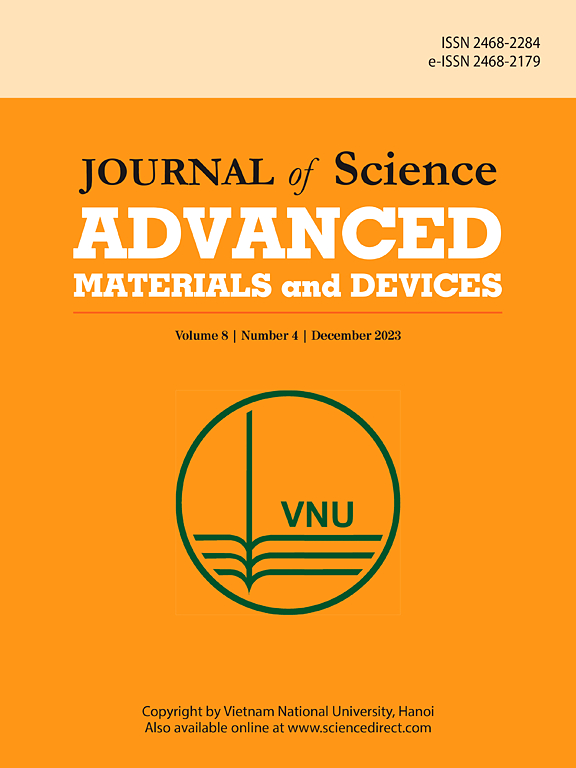Enhancing the performance of Bi2O3–ZnO semiconductor bilayers for photoelectrochemical electrodes by strategically engineering oxygen vacancies
IF 6.8
3区 材料科学
Q1 MATERIALS SCIENCE, MULTIDISCIPLINARY
Journal of Science: Advanced Materials and Devices
Pub Date : 2025-04-25
DOI:10.1016/j.jsamd.2025.100895
引用次数: 0
Abstract
This study successfully synthesized sheet-like triangular Bi2O3 using the hydrothermal method and subsequently annealed it in a hydrogen-contained atmosphere to effectively introduce oxygen vacancies. ZnO was fabricated through sputtering at elevated substrate temperatures, which also facilitated the formation of oxygen vacancies. We prepared Bi2O3/ZnO composites to assess their performance in photoelectrochemical (PEC) and photocatalytic applications under illumination. Oxygen vacancies significantly enhance the materials' charge separation capabilities, resulting in increased photocurrent density and reduced interfacial resistance while also boosting the number of surface active sites. Furthermore, control over the annealing conditions and substrate temperatures can optimize the generation of oxygen vacancies, thereby enhancing the performance of the composites. Introducing oxygen vacancies and establishing a Z-scheme structure in Bi2O3 and ZnO represent effective strategies for advancing the potential applications of oxide semiconductor composites in PEC electrodes.
策略性地设计氧空位以提高Bi2O3-ZnO半导体双分子层的光电电化学电极性能
本研究成功地利用水热法合成了片状三角形Bi2O3,随后在含氢气氛中进行退火,以有效地引入氧空位。ZnO是在衬底温度升高的情况下溅射制备的,这也促进了氧空位的形成。我们制备了Bi2O3/ZnO复合材料,以评估其在光照下的光电化学和光催化应用性能。氧空位显著增强了材料的电荷分离能力,从而增加了光电流密度,降低了界面电阻,同时也增加了表面活性位点的数量。此外,控制退火条件和衬底温度可以优化氧空位的产生,从而提高复合材料的性能。在Bi2O3和ZnO中引入氧空位和建立Z-scheme结构是推进氧化物半导体复合材料在PEC电极中的潜在应用的有效策略。
本文章由计算机程序翻译,如有差异,请以英文原文为准。
求助全文
约1分钟内获得全文
求助全文
来源期刊

Journal of Science: Advanced Materials and Devices
Materials Science-Electronic, Optical and Magnetic Materials
CiteScore
11.90
自引率
2.50%
发文量
88
审稿时长
47 days
期刊介绍:
In 1985, the Journal of Science was founded as a platform for publishing national and international research papers across various disciplines, including natural sciences, technology, social sciences, and humanities. Over the years, the journal has experienced remarkable growth in terms of quality, size, and scope. Today, it encompasses a diverse range of publications dedicated to academic research.
Considering the rapid expansion of materials science, we are pleased to introduce the Journal of Science: Advanced Materials and Devices. This new addition to our journal series offers researchers an exciting opportunity to publish their work on all aspects of materials science and technology within the esteemed Journal of Science.
With this development, we aim to revolutionize the way research in materials science is expressed and organized, further strengthening our commitment to promoting outstanding research across various scientific and technological fields.
 求助内容:
求助内容: 应助结果提醒方式:
应助结果提醒方式:


